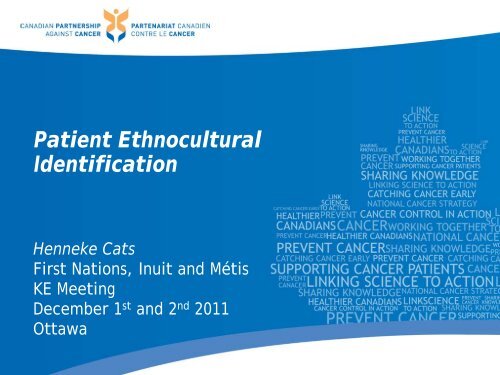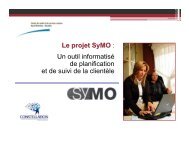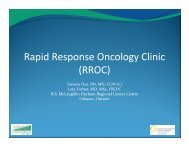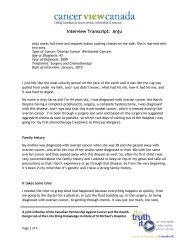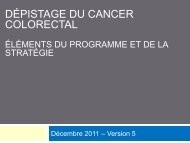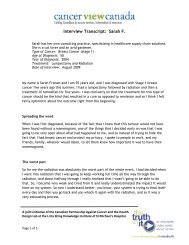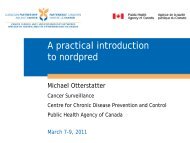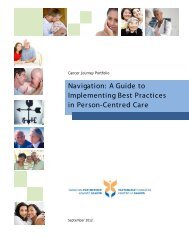Patient Ethnocultural Identification Henneke Cats - cancerview.ca
Patient Ethnocultural Identification Henneke Cats - cancerview.ca
Patient Ethnocultural Identification Henneke Cats - cancerview.ca
Create successful ePaper yourself
Turn your PDF publications into a flip-book with our unique Google optimized e-Paper software.
<strong>Patient</strong> <strong>Ethnocultural</strong><strong>Identifi<strong>ca</strong>tion</strong><strong>Henneke</strong> <strong>Cats</strong>First Nations, Inuit and MétisKE MeetingDecember 1 st and 2 nd 2011Ottawa
Presentation topics• Introduction to The Bridge Consulting Group Inc.• Project description• Approach to the work• Findings so far• Obstacles and opportunities encountered• Disseminating the results2
Who we areStrategy and organizational change facilitation firmWork with senior leaders & boards– Clarify through evidence … new patterns?– Work through options & choices … opposing views?– Offer implementation support … end-user tests?3
Our project teamLoraine Marrett, PhDResearch Scientific AdvisorDrs. <strong>Henneke</strong> <strong>Cats</strong>Principal InvestigatorDiana WithrowPhD Candidate, EpidemiologyResearch AssociateWendy Neelin, Q.A.AAdministrative Support4
People-specificAction PlanCommunitybasedHHR skills& <strong>ca</strong>pacity, andcommunityawareness2. S<strong>ca</strong>n &analyzecommunity<strong>ca</strong>ncerprevention andscreeningawarenesssurveys1. Survey edu<strong>ca</strong>tional needsof front-line health workers inInuit communitiesCommunityawarenesssurveysIdentify/facilitatedevelopment ofedu<strong>ca</strong>tional programsCommunity awareness<strong>ca</strong>mpaigns2012-17Share leadingpractices acrossall regions andpopulations2011/125. S<strong>ca</strong>n andanalyze patientidentifi<strong>ca</strong>tionsystemsFN/I/Mpatientidentifi<strong>ca</strong>tionCulturallyresponsiveresourcesand services3. S<strong>ca</strong>n leadingpractices (includingnavigation andtraditional models)across <strong>ca</strong>ncercontrol spectrum.Implementing @ YourSide Colleague®Cancer Care course inFirst Nations regionsShare leadingpractices acrossall regions andpopulationsShare/develop newmodels of <strong>ca</strong>re across<strong>ca</strong>ncer control spectrum4. S<strong>ca</strong>n andanalyze leadingmodels of <strong>ca</strong>reAccess to<strong>ca</strong>re inremoteand ruralcommunitiesLeadership:6. Facilitating cross-sectoral collaboration on social determinants of health7. Raising the profile of <strong>ca</strong>ncer among First Nations, Inuit and Métis leaders5
Project descriptionGoal . Identify leading practices that <strong>ca</strong>n be shared across Canada• Determine barriers in identifying the ethno-cultural identity of<strong>ca</strong>ncer patients among First Nations, Inuit and Métis peoplesScope . Cancer & other health systems• Regional, P/T, federal and First Nations, Inuit and Métis jurisdictionsResults . Inspire adoption, adaptation & new creation of ethnoculturalidentifiers in <strong>ca</strong>ncer/ health databases• Inform the development of common standards• Improve ability to turn relevant information into improvements in<strong>ca</strong>ncer control6
High level workplanMethodology & Analyti<strong>ca</strong>l FrameworkLiterature ReviewData CollectionAnalysis & RecommendationsJune - JulyMay – AugustJuly – NovemberSept – DecemberRemaining work:1. Finalize Inventory of Profiles December 92. Finalize Report January 317
MethodologyWHATStep I: Identify FNIM <strong>Patient</strong> <strong>Identifi<strong>ca</strong>tion</strong> SystemsStep II: Describe & Categorize them: ProfilesStep III: Assess themDatabasesDatabasesInventoryLeading PracticesDatabasesData Collection ToolAssessment CriteriaHOWSearch Method & Screener8
Search method: 1. focus on people, andwhen they may self-identifyAnswer census/ survey questionsRegister for P/T/F health insuranceDuring a clini<strong>ca</strong>l/professional encounterRegister a life eventRegister for program/ serviceRegister as aboriginal status person/beneficiary / citizen9
Search method: 2. combine with taxonomyof health entitlementsHealth Plan EnrolleesClient Registry & <strong>Identifi<strong>ca</strong>tion</strong> ManagementPublic HealthPrimary CareHome & Community CareInstitutional CareClinics, et al.PH Units(communi<strong>ca</strong>ble)Schools(immunization)FPs, nurses &teamsEye, ear, teethprofessionals,midwivesHome <strong>ca</strong>reCommunity health centresCommunity agenciesCommunity mental healthHospitals(inpatient,ambulatory)Long term <strong>ca</strong>reClinics (e.g. alliedhealth)Screening programsPharmaciesLabsSpecializations: babies & moms, the aged, chronic diseases, mental health & addictionsExample: DB with <strong>ca</strong>ncer patients10
Example: Northwest Territories <strong>ca</strong>ncerregistrySource:Maria Santos, Territorial Epidemiologist, Population HealthDepartment of Health and Social Services, Government of the Northwest Territories11
Source form: <strong>ca</strong>ncer registration?12
Source form: health <strong>ca</strong>rd appli<strong>ca</strong>tionThe health <strong>ca</strong>rd appli<strong>ca</strong>tion process allows NWTresidents to voluntarily self-identify at the timeof registration - with supporting documentation - asstatus Indian, Métis, Inuit, Inuvialuit or IndigenousMétis:13
Developing a data collection tool for theprojectgeneric process for collecting and usingethnocultural identity dataProcess view serves as underlying logic fortool & analysis14
Data collection tool (1 st of 4 screens)15
Early learnings: where there’s a will …1. Broad based interest, ability & willingness to augmenthealth databases w/ identifiers– Ability: funding, skill development, real projects2. Profiling 27-46 databases and 6 infrastructure pieces– Recent: 19 of these new in 2010/11– From Atlantic to Pacific, North to South, across service domains– Inventory of Profiles: a menu of options & context-sensitive3. Need both responders and linkage impli<strong>ca</strong>tions16
Obstacles & opportunitiesBarriers experienced: Time of informants• Many informants feel understaffed & overcommitted• First Nations, Inuit and Métis communities more so• It takes time to build relations & trustOpportunities to improve time efficiencyThe [lo<strong>ca</strong>l] project concluded it was larger than could be managed lo<strong>ca</strong>lly …needed a provincial process … and a national framework• Guidelines: emerging consensus min. value set: FN, I, M• Infrastructure / harmonization: e.g. Bi-/Tripartitepoliti<strong>ca</strong>l process, Cultural Competency training, PrivacyReview harmonization17
Disseminating the resultsKeen interest in results:1. First Nations, Inuit and Métis organizations2. Beyond <strong>ca</strong>ncer: chronic disease, public health,primary <strong>ca</strong>re3. At national, P/T, and regional & community levelsResults seen as related to a number of priority topics:• Closing gaps, equity, diversity, community outreach• <strong>Patient</strong> navigation & provision of culturally safe <strong>ca</strong>re• Planning & priority setting• Indi<strong>ca</strong>tor development• Capacity building• Research18
Proposed table of contents for reportInventory of Profiles1. Acknowledgements2. Introduction3. Cross reference chart4. Health databases –P/T, Regional/ Lo<strong>ca</strong>l5. Health databases –NationalExhibitsAnalyti<strong>ca</strong>l Report1. Executive Summary2. Introduction3. Objective of Project4. Methodology &Analyti<strong>ca</strong>l Framework5. Results6. Discussion7. RecommendationsBibliographyAppendices19
Questions?20


